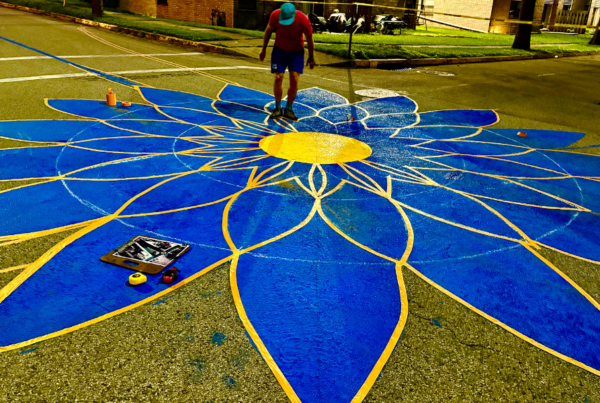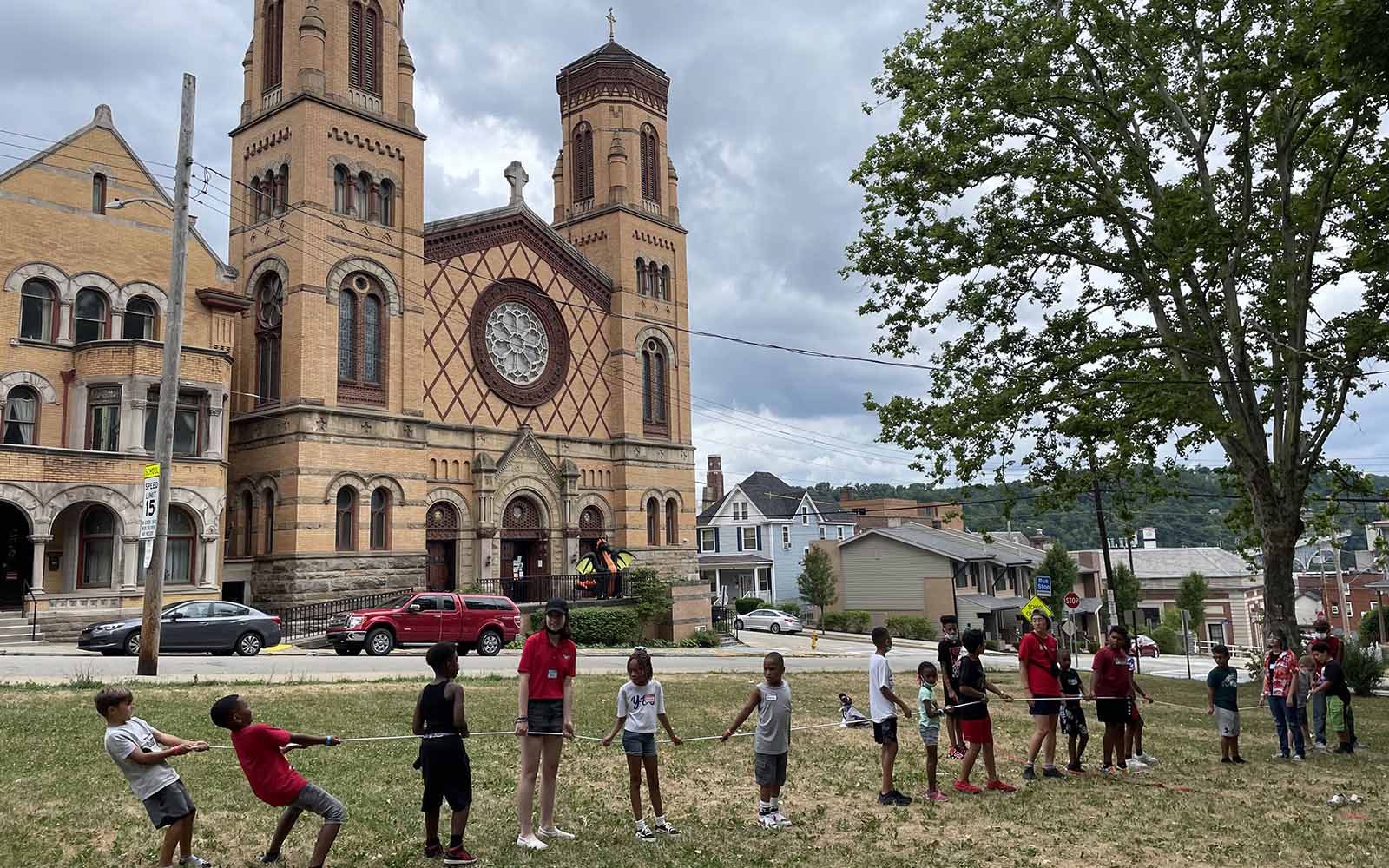
Homestead youth engage in a group activity across from Dragon’s Den, which occupies the space that was formerly the St. Mary Magdalene church.
Community Spotlight—Dragon’s Den
The Community Spotlight series features the efforts of Rivers of Steel’s partner organizations, along with collaborative partnerships, that reflect the diversity and vibrancy of the communities within the Rivers of Steel National Heritage Area.
By Gita Michulka, Contributing Writer
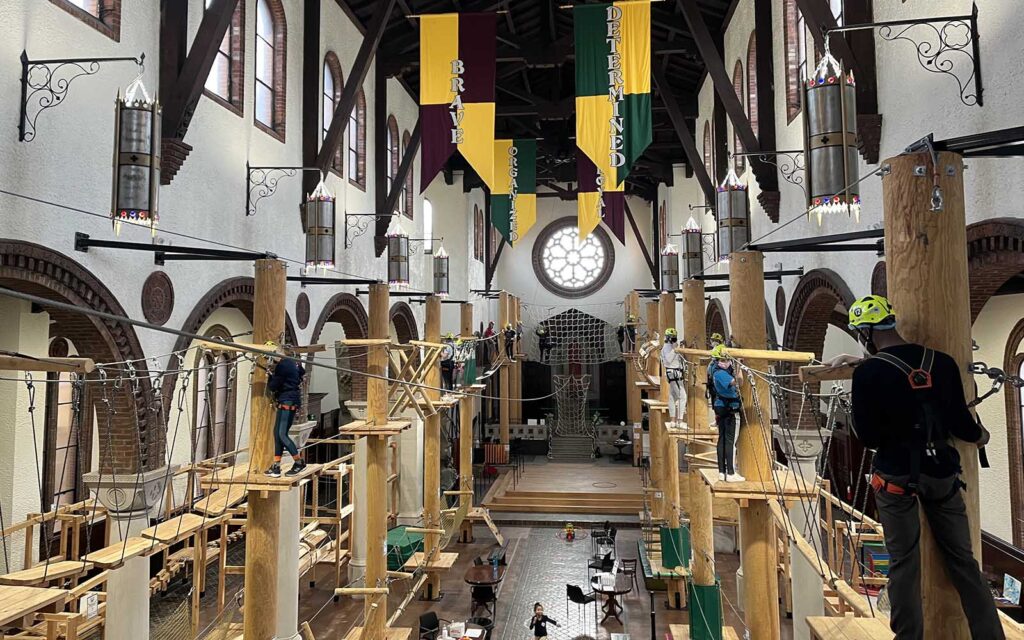
The two-story ropes course at Dragon’s Den.
Helping Homestead Youth Reach Great Heights
When Giulia and Bill Petrucci purchased the former St. Mary Magdalene church in Homestead, Pennsylvania, in 2015, they knew they wanted to create a space where the community, especially its children, could come together. At the time, they never imagined the space would be centered around a two-story ropes course and a zip line that ran from the old choir loft to the altar.
While the couple was working out how to restore such a large, open space in a way that was financially feasible, they considered closing off the top half of the cathedral to make heating and cooling more practical.
“We knew we wanted to do something for children, but the issue was that in a part of our church, we have the ceiling that is more than fifty feet high. So the challenge was how are we going to heat this big, open space,” says Giulia Lozza Petrucci, Executive Director of Dragon’s Den. “And so the initial idea was to build a second floor because this way you could heat one floor and not the other one, but then that would mean having to cover all the beautiful details of this church. The ceiling is absolutely stunning. We have terracotta medallions with different faces on top of each window, and everything would have been, you know, hidden.”
Since a key piece of their mission was also to preserve the history of the space, installing a second floor that would cut off visitors from the church’s grandeur was not an option. Luckily, a trip to Italy provided unexpected inspiration.
“When my kids and I went to Italy that summer, my kids went to tour a ropes course with my aunt. They came home and they started talking about being terrorized and walking in the air and thinking that they were going to die,” says Petrucci with a laugh. “But then actually they didn’t. And they loved it so much, and I could see a difference in self-confidence and joy from my own children.”
Curious about their experience, Petrucci visited the ropes course the following day to learn more.
“In Italy, field trips must be educational. But I really didn’t understand what was educational about moving from one platform on a tree to another,” she says with another laugh. “To me it looked more like a physical thing, like a gym or something. I really didn’t see the connection until I talked to the teachers, and they told me that it’s part of the curriculum because there are so many studies that support how doing ropes courses helps team building and working together among participants, and also following directions, problem solving, and an increase in self-efficacy, self-control, focus, and self-confidence.”
After doing some more research into the benefits of participating in a ropes course, the Petruccis had made up their minds.
“So that is when the decision was made,” Petrucci continues. “We realized that we could do a second floor without covering the beauty, because our ropes courses would allow people to move on two different levels as if there were two floors. But it’s open, so you see all the beautiful details while walking next to it. Imagine when you go to a cathedral, you see things that are, what, thirty feet away, right? Well, in our case, you walk next to it.”
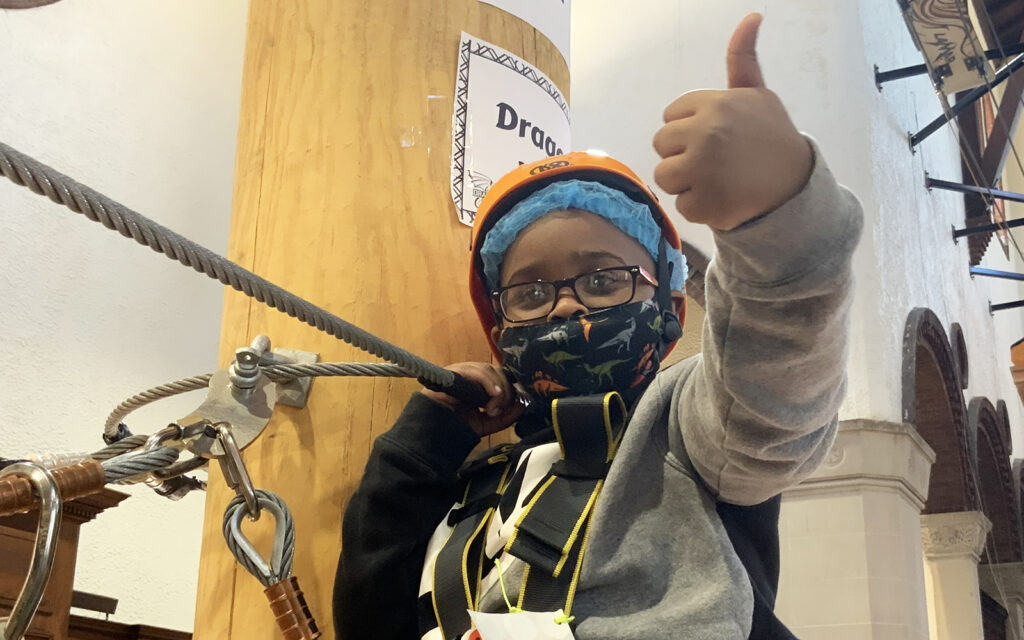
A youth on the ropes course at Dragon’s Den.
A neighborhood Oratorio in Homestead
Beyond the benefits a ropes course would add to their programming, Petrucci saw potential in the location of St. Mary Magdalene to recreate a space familiar to her from growing up in Italy.
“We have one little church in every little town in Italy, and next to each church is a safe space called an oratorio, where children are free to walk to after school,” explains Petrucci. “And there are structured and unstructured activities, a space to run, a space to do homework there.”
A desire to create an oratorio for the Homestead community solidified the concept of Dragon’s Den.
“The position of St. Mary Magdalene being across the street from Propel Charter School and a block and a half from Barrett Elementary school and across the street from a park makes it very, very easy for the kids to just walk to us independently,” says Petrucci.
Dragon’s Den has been deeply embedded in the community from the start. The Petruccis were drawn to St. Mary Magdalene not only for its beauty, but also because of the stories they had heard about how hard the neighborhood rallied to keep its doors open. The organization’s name—a nod to the church’s former school whose mascot was a dragon—was chosen through a large community-wide naming contest.
“One of the people that submitted a name, actually I remember that email because it was a turning point, like a light bulb went off,” says Petrucci. “This person was saying, ‘You want to preserve our church? Please also preserve our past.’”
Recently the Petruccis were afforded a unique opportunity to do just that. Thanks in part to funding from a Rivers of Steel Mini-Grant, the organization will be able to restore an original model of the church that was found in the rectory.
“It’s an historic model because it’s assumed that it was built in 1895 by architect Frederick Sauer, who is the architect that built St. Mary Magdalene,” says Petrucci. “But what happened at that time, there was a huge fire in 1934 that destroyed completely the old St. Mary Magdalene. So what you see now, the building we are in, it was rebuilt—but that model, it’s the only remaining evidence of what the historic building looked like before its destruction.”
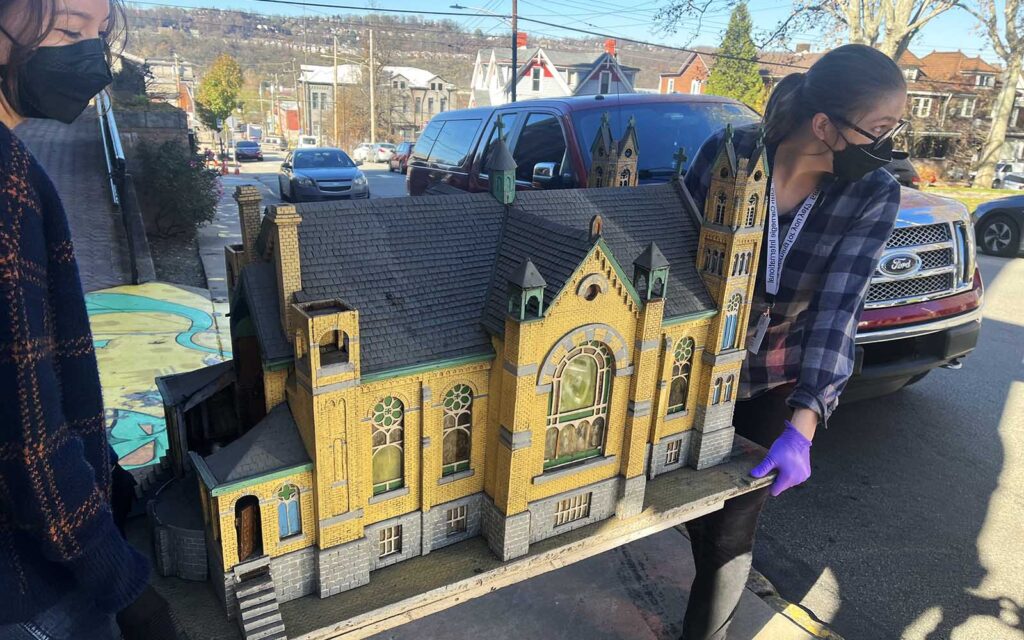
Removing the model for restoration.
Mary Wilcop, an object conservator at the Carnegie Museum of Art, will clean the model, which provides a unique architectural glimpse into the Steel Valley’s past. Once the restoration is complete, the model will provide an invaluable tourist attraction as part of the area’s heritage.
This attention to the site’s history and the neighboring community, along with the distinctive programming a ropes course offers, has endeared Dragon’s Den to the Homestead families it serves. Despite opening at the onset of a pandemic, the programs at Dragon’s Den have been wildly popular out of the gate. The ropes courses and open space of the church naturally lent to social distancing while offering a chance for physical activity and social interactions. Since then, the programs at Dragon’s Den have grown to include after-school programs, summer camps, community events, and facility rentals for corporate retreats and team building.
Giulia Petrucci is eager to point out that beyond reading about it and seeing pictures, you really need to see the space to appreciate all that it has to offer. She recalls how even a colleague of the ropes course designer, who had seen hundreds of photos of the space, marveled during his first in-person visit. “He said, ‘Well, I believe that Dragon’s Den is like the pyramids in Egypt. It doesn’t matter how many pictures you’ve seen, it doesn’t matter how many words you have read—you don’t fully appreciate them until you are there.”
Learn more about the history, programs, and ropes course opportunities at Dragon’s Den at dragonsdenpgh.org.
About the Mini-Grant Program
Rivers of Steel’s Mini-Grant Program assists heritage-related sites and organizations as well as municipalities within the Rivers of Steel National Heritage Area to develop new and innovative programs, partnerships, exhibits, tours, and other initiatives. Funded projects support heritage tourism, enhance preservation efforts, involve the stewardship of natural resources, encourage outdoor recreation, and include collaborative partnerships. Through these efforts, Rivers of Steel seeks to identify, conserve, promote, and interpret the industrial and cultural heritage that defines southwestern Pennsylvania.
The Rivers of Steel National Heritage Area is one of twelve supported by the Pennsylvania Department of Conservation and Natural Resources (DCNR). Funding is provided via DCNR’s Community Conservation Partnerships Program and the Environmental Stewardship Fund to Rivers of Steel, which administers the Mini-Grant Program. Dragon’s Den is one of eight organizations who received Mini-Grant funding through this program in 2022.
 Gita Michulka is a Pittsburgh-based marketing and communications consultant with over 15 years of experience promoting our region’s arts, recreation, and nonprofit assets.
Gita Michulka is a Pittsburgh-based marketing and communications consultant with over 15 years of experience promoting our region’s arts, recreation, and nonprofit assets.
If you’d like to know more about community projects supported by the Mini-Grant Program, read Gita’s recent article about Meadowcroft Rockshelter.



